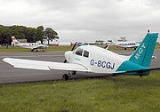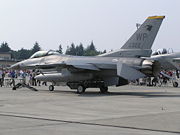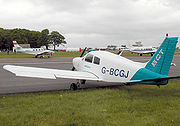
Stabilator
Encyclopedia

Elevator (aircraft)
Elevators are flight control surfaces, usually at the rear of an aircraft, which control the aircraft's orientation by changing the pitch of the aircraft, and so also the angle of attack of the wing. In simplified terms, they make the aircraft nose-up or nose-down...
and a horizontal stabilizer. Most fixed-wing aircraft
Fixed-wing aircraft
A fixed-wing aircraft is an aircraft capable of flight using wings that generate lift due to the vehicle's forward airspeed. Fixed-wing aircraft are distinct from rotary-wing aircraft in which wings rotate about a fixed mast and ornithopters in which lift is generated by flapping wings.A powered...
control pitch using a hinged horizontal flap — the elevator — attached to the back of the fixed horizontal stabilizer, but some aircraft make the entire stabilizer movable.
General aviation

Aerodynamic center
The torques or moments acting on an airfoil moving through a fluid can be accounted for by the net lift applied at some point on the foil, and a separate net pitching moment about that point whose magnitude varies with the choice of where the lift is chosen to be applied...
(at the tail's quarter-chord). This is the point at which the pitching moment is constant regardless of the angle of attack, and thus any movement of the stabilator can be made without added pilot effort. An airplane certified by the appropriate regulatory agency (e.g. the US Federal Aviation Administration
Federal Aviation Administration
The Federal Aviation Administration is the national aviation authority of the United States. An agency of the United States Department of Transportation, it has authority to regulate and oversee all aspects of civil aviation in the U.S...
) must show an increasing resistance to an increasing pilot input (movement), so to provide this resistance, stabilators on small aircraft contain an anti-servo tab
Servo tab
A servo tab is a small hinged device installed on an aircraft control surface to assist the movement of the control surface.-Servo tabs:...
(sometimes combined with the trim tab) that deflects in the same direction as the stabilator, thus providing an aerodynamic force resisting the pilot's input. General aviation aircraft with stabilators include the Piper Cherokee
Piper Cherokee
The Piper PA-28 Cherokee is a family of light aircraft designed for flight training, air taxi, and personal use. It is built by Piper Aircraft....
and the Cessna 177
Cessna 177
The Cessna 177 Cardinal is a light, high-wing general aviation aircraft that was intended to replace Cessna's 172 Skyhawk. First announced in 1967, it was produced from 1968 to 1978.-Development:...
.
Military

De Havilland DH.77
-See also:-Notes: There was an agreement between de Havilland and Gloster to co-operate on the development of de Havilland military aircraft.-References:*Jackson, A.J. De Havilland Aircraft since 1909. London:Putnam, Third edition, 1987. ISBN 0-85177-802-X....
offering for a Royal Air Force
Royal Air Force
The Royal Air Force is the aerial warfare service branch of the British Armed Forces. Formed on 1 April 1918, it is the oldest independent air force in the world...
fighter used an all flying tail.
Stabilators were developed in response to the need to achieve adequate pitch control in supersonic flight, and are almost universal on modern military combat aircraft. All non-delta-winged supersonic aircraft use stabilators because with conventional control surfaces, shock wave
Shock wave
A shock wave is a type of propagating disturbance. Like an ordinary wave, it carries energy and can propagate through a medium or in some cases in the absence of a material medium, through a field such as the electromagnetic field...
s can form past the elevator hinge, causing severe mach tuck
Mach tuck
Mach tuck is an aerodynamic effect, whereby the nose of an aircraft tends to pitch downwards as the airflow around the wing reaches supersonic speeds...
.
The British wartime Miles M.52
Miles M.52
The Miles M.52 was a turbojet powered supersonic research aircraft project designed in the United Kingdom in the mid 1940s. Design work was undertaken in secrecy between 1942 and 1945. In 1946 the Air Ministry prudently but controversially changed the project to a series of unmanned rocket-powered...
supersonic project had stabilators though the design flew only as a scale rocket. The contemporary US supersonic project, the Bell X-1
Bell X-1
The Bell X-1, originally designated XS-1, was a joint NACA-U.S. Army/US Air Force supersonic research project built by Bell Aircraft. Conceived in 1944 and designed and built over 1945, it eventually reached nearly 1,000 mph in 1948...
, adapted its variable incidence tailplane into an all-moving tailplane (based on Miles M.52 data) and was operated successfully. The North American Aviation F-86 Sabre
F-86 Sabre
The North American F-86 Sabre was a transonic jet fighter aircraft. Produced by North American Aviation, the Sabre is best known as America's first swept wing fighter which could counter the similarly-winged Soviet MiG-15 in high speed dogfights over the skies of the Korean War...
, the first USAF aircraft which could go supersonic (although in a shallow dive) was introduced with a conventional horizontal stabilizer with elevators, which was eventually replaced with a stabilator.
Stabilators are also known in military terminology as all-moving or all-flying tailplanes. When stabilators can move differentially to perform the roll control function of ailerons, as they do on many modern fighter aircraft
Fighter aircraft
A fighter aircraft is a military aircraft designed primarily for air-to-air combat with other aircraft, as opposed to a bomber, which is designed primarily to attack ground targets...
they become tailerons or rolling tails. A stabilator can also be mounted in front of the main wing
Wing
A wing is an appendage with a surface that produces lift for flight or propulsion through the atmosphere, or through another gaseous or liquid fluid...
in a canard
Canard (aeronautics)
In aeronautics, canard is an airframe configuration of fixed-wing aircraft in which the forward surface is smaller than the rearward, the former being known as the "canard", while the latter is the main wing...
configuration.
Stabilators on military aircraft have the same problem of overcontrol as general aviation aircraft. In older jet fighter aircraft, a resisting force was generated within the control system, either by springs or a resisting hydraulic force, rather than by an external anti-servo tab. For example in the F-100 Super Sabre
F-100 Super Sabre
The North American F-100 Super Sabre was a supersonic jet fighter aircraft that served with the United States Air Force from 1954 to 1971 and with the Air National Guard until 1979. The first of the Century Series collection of USAF jet fighters, it was the first USAF fighter capable of...
, springs were attached to the control stick to provide increasing resistance to pilot input. In modern fighters, control inputs are moderated by computers ("fly by wire
Fly by Wire
Fly by Wire: The Geese, the Glide, the Miracle on the Hudson is a book written in 2009 by William Langewiesche about US Airways Flight 1549 with emphasis on the role played by the advanced fly-by-wire flight control system of the aircraft....
"), and there is no direct connection between the pilot's stick and the stabilator.
Airliners

Angle of attack
Angle of attack is a term used in fluid dynamics to describe the angle between a reference line on a lifting body and the vector representing the relative motion between the lifting body and the fluid through which it is moving...
) horizontal stabilizers. However, such adjustable stabilizers are not the same as stabilators; a stabilator is controlled by the pilot's control yoke (or stick), and an adjustable stabilizer is controlled by the trim system. One example of an airliner with a genuine stabilator used for flight control is the Lockheed L-1011
Lockheed L-1011
The Lockheed L-1011 TriStar, commonly referred to as the L-1011 or TriStar, is a medium-to-long range, widebody passenger trijet airliner. It was the third widebody airliner to enter commercial operations, following the Boeing 747 and the McDonnell Douglas DC-10. Between 1968 and 1984, Lockheed...
.
External links
- Stabilators (NASA) — Includes Java applet

